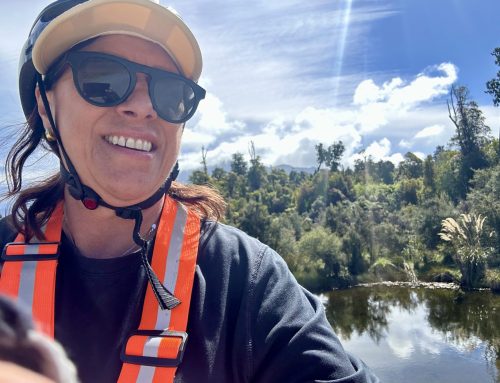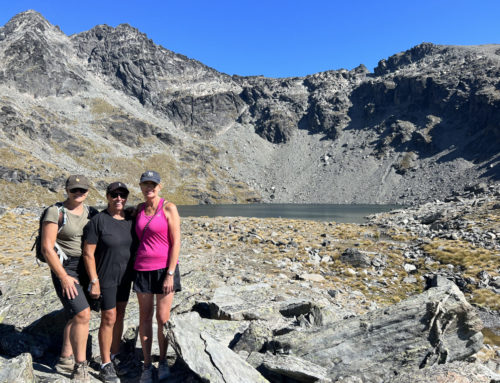I’ve just returned from a guided expedition of the Hollyford Track, a magnificent three-day adventure. I’ve come away with great satisfaction having traversed a spectacular piece of New Zealand and learnt so much along the way, thanks to our passionate and informative guides, Bex and Ei.

Walking on day one in the rain added to the adventure
The Hollyford Track starts in the heart of the Fiordland’s National Park and meanders its way to Martin’s Bay on the West Coast. While a reasonable level of fitness is required, the walk is not arduous and we stopped often to look at places and things of interest.
Ngāi Tahu Tourism is the parent company for the Hollyford Track Wilderness Experience. Back in the 1870 Ngai Tahu’s ancestors guided the first European explorers, teaching them the ways of the forest. This is what our guides did for us. Bex and Ei’s story-telling made the forest and ocean came alive as we connected with our ancestors, pioneers, fauna and flora and mountains making this walk unique.
Being the kind of gal I am, carrying my food, bedding and clothing with no room for ‘chardy’ is not my idea of fun so thanks to this guided walk there is an alternative….hotties, duvets, delicious cuisine and chilled wine.
Day one
Day one we set off by minibus from Te Anau, to the beginning the Hollyford track. However, the region is still recovering from a significant weather event over a year ago. On 3 February 2020, half a metre of rain fell in a single day, more than the normal amount for the entire month of February. The rain triggered flooding and slips and a State of Emergency was declared in Fiordland.

The remaining damage from the weather event on 3 February 2020
As a result, the road and part of the actual track were severely damaged. A small section is still under repair. So, the only way in was by helicopter .
Landing at Sunshine Shelter, it was anything but sunny. With an annual rainfall of seven metres it was not surprising it was drizzling. However, the rain didn’t detract from the walk. Rather it added another dimension with waterfalls, glistening green foliage, a thousand shades of green. As we got deeper into the bush the birdsong in the canopy got stronger. The predator trapping has made a real difference to the native bird population.

Arriving at Sunshine Shelter

Thanks to Sunshine Shelter we could eat our lunch out of the rain
There was never a dull moment as our guides who were both local girls kept us entertained with tales about survival and the environment. However, I’ll never forget the tale about the tree fern or Katote.
Bex explained with great detail and enthusiasm the differences between the common male and female tree ferns. ‘Cyathea smithii, referred to as Cynthia is the female tree fern. Her leaves are soft for making a forest mattress, her skirt is long, however if you eat her koru (spiral top of a fern frond) you will get diarrhea. In comparison, Dicksonia squarrosa, or Dick for short is the male tree fern. His fronds are hard, he’s hairy with no skirt, but you can eat his koru.

‘Cynthia’, the female tree fern

The koru of the tree fern
Another fascinating fact we learnt was about the bracket fungi. Once burnt it will continue to smoulder for some time. When the early Maori moved around the fiords the wahine or women would carry the smouldering fungi in a flax basket or kete. When the fungi were fanned with dry kindling a fire would start.

The smouldering bracket fungi is great for lighting fires
After reaching the Homer Saddle at just 168 metres, we were on the home straight to Pyke Lodge, our home for the first night. Greeted by our hosts Alan and Sandra, we were warmly welcomed inside with a piping hot cup of tea, before a well-earned shower and dry clothes. The venison medallions followed by lemon tart were delicious before we collapsed into our twin room for a good nights sleep.

Breakfast at Pyke Lodge

Our lovely hosts Alan and Sandra cooking our breakfast
Our room were warm and cosy and the hotties added another level of love and hominess. It wasn’t long before I was sound asleep.
Day two
Our second day we awoke to the sound of Ei singing, followed by a delicious cooked breakfast. After a short walk we arrived at the jetboat mooring and headed down the Hollyford River and into Lake McKerrow. We travelled this section of the expedition by water as the Demons Track alongside the lake, is challenging and can be treacherous. It has been left untouched to give people an idea of the arduous nature of the backcountry tracks.

Leaving the jet boat on Lake McKerrow
After leaving the jetboat we walked for about 15 kilometres learning about the first Maori to arrive in the area. A coastal village in Martin’s Bay became an important settlement for the Ngai Tahu tribe between 1650 and 1800 because of the abundant seafood and food from the forest and lake. Captain Alabaster, a whaler, was one of the first Europeans to explore the valley and in 1863 he met Ngai Tahu Chief Tutoko at Martin’s Bay. He named the chief’s daughters Sara and May. Several months later Dr James Hector, a geologist from Otago named the hills on either side of the bay, Sara and May.
Later in the day we arrived at the early pioneering settlement of Jamestown. Jamestown was a settlement developed on the picturesque shores of Lake McKellow in the 1870s, by James Macandrew, the then Superintendent of Otago. He created a township that was to have been the genesis of a Greater Otago.

This is all that’s left of Jamestown
Although the first settlers found their new home beautiful the hardship was unfathomable. Supplies delivered by ship were sporadic so they had to survive on fish and native birds (wekas, kiwi and pigeon).
Not surprisingly, the Jamestown venture proved disastrous and the inevitable happened, a steady exodus. The exception being Daniel and Margaret McKenzie and their sons who lasted over 30 years in the Martin’s Bay area. We should all be pleased the project failed and this beautiful part of New Zealand remains untouched.
After a full day we arrived at Martin’s Lodge, our home for the second night. The spacious lodge, delicious home cooking and welcoming hosts all added to a convivial and relaxing night.
Day Three
Up early, our third morning was spent exploring the West Coast beach at Martin’s Bay Spit, separating the powerful Tasman Sea from the Hollyford Valley. The beach was dramatic with the surf surging and a great undertow.

Martin’s Bay on the West Coast

Heading back to Martin’s Lodge before helicoptering to Milford
Reserves of pounamu or greenstone were plentiful in the Hollyford Valley for centuries. We walked the land where the ancient pounamu trails once were as the Maoris traded this treasured stone carved into tools and sharp weapons. Ngāi Tahu have legal guardianship of all raw pounamu from the Ngāi Tahu tribal area, but we never found any so there was never a question of whether we should take it!

Looking for pounamu
Finally, after our farewell lunch at Martin’s Bay Lodge we boarding the helicopter for a scenic flight along the rugged coast to Milford Sound.We flew over the sheer cliffs of the fiord as water plummeted down its sides. We passed abundant rain forests and finally Mitre Peak came into view.

On the bus back to Te Anau, our trip had ended. The forest we walked, the rivers we crossed were all bought to life by the stories from Bex and Ei. It was more than a Great Walk. The Hollyford Track was a Great Great Walk and I felt I had walked in the footsteps of our ancestors.
For more information on the Hollyford Track Guided Experience






Very good Jane, I enjoyed reading about your three days in the bush and on the beach.